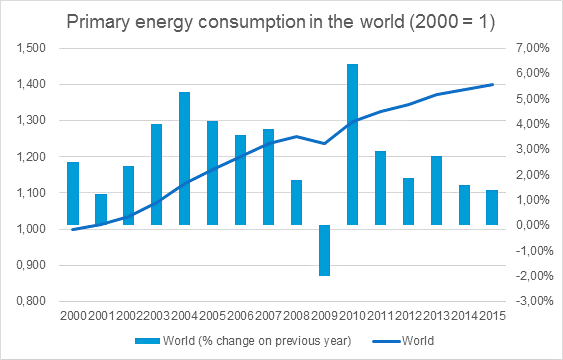By Benedict De Meulemeester on 26/09/2016
Topics: Energy Markets
It is a strongly imbedded belief in the world of energy analysis that demand for energy can only grow. In terms of energy procurement, this leads many buyers to bullish biases, making them buy too soon or at high price levels, as they believe increasing demand will make prices rise. However, as commented earlier on this blog, we have recently seen a slowdown of the growth of worldwide energy demand. It’s true of course that the last decade hasn’t excelled in terms of economic growth. However, in many parts of the world now, an extra percentage of GDP doesn’t necessarily mean an extra percentage of energy use. In 2015, the world’s primary energy consumption grew by just 1%, whereas GDP, according to the World Bank, grew by 2,47%. Have we cracked the code and can we – as of now – increase our economies without using ever larger quantities of energy? Or will a next phase of strong economic growth come with an acceleration in energy consumption growth again?

Fig. 1: Primary energy consumption in the world (Source: BP Statistical Review)
The graph on the world’s primary energy consumption is showing us how during 2000 – 2007 strong economic growth came with large extra quantities of energy. The economic crisis of 2008 & 2009 brought that down sharply, only to be followed by a record year-on-year increase in 2010 as particularly China – the world’s largest energy consumer – revived quickly. But then the energy growth started to slow down. Last year, worldwide primary energy consumption grew by just 1%.
It should be clear that not all parts of the world are equally contributing to this reduction in energy voraciousness. As can be seen from the graphs below, the traditional economies in Europe and Northern-America have been in the lead. In the European Union, we even see a clearly declining trend that started in 2006, which is before the striking of the economic crisis. This is the moment that many energy efficiency programs devised in the framework of Europe’s climate policy have come into effect and I believe that there is a clear causal relationship here. In North-America, energy consumption in 2015 was at the same level as in 2000. US primary energy consumption in 2015 dropped 0,9% compared to 2014, despite a 2,4% increase in GDP.
(Regarding Europe, critical observers might remark that there has been an increase in EU consumption in 2015 – to which I would respond that this was a year with cold winter weather.)

Fig. 2: Primary energy consumption in different parts of the world (Source: BP Statistical Review)
The lines on the right hand side don’t show much slowing-down of the hunger for more energy in the emerging economies. However, in China e.g., energy consumption grew by just 1,5% last year, which is far below the 16,6% and 17% that we saw in 2003 and 2004. On the one hand, this slowdown in hunger for ever more energy can be explained by the mechanics of economic development itself. In the first phase of its economic development, growth in a country like China came from the growth of basic, energy-intensive industries such as steel production, causing energy demand to go up quickly. On top of that, the growing middle classes started to enjoy energy-consuming luxuries such as cars, a larger house, air-conditioning, frozen foods, etc. However, once a certain level is reached, further economic growth comes from less energy-intensive industries and services and the middle class stops to grow, causing the growth of energy consumption to slow down. But could it be a deeper trend, and is the world starting to copy Europe’s example of consciously improving its energy efficiency?
When I talk to people around me, I observe that most of them don’t realize at all what a revolution they’ve gone through in their daily lives in terms of energy efficiency. To just name a few examples:
And not just households have reduced their energy consumption. If I look at our clients, mostly large industrial users, all of them are running energy efficiency programs, inspired by government regulations, demands by clients and other stakeholders or just environmental consciousness. Implementing more efficient technology and practices, they have all reduced the energy-intensity of their production. And many of them are not only reducing energy consumption in relative (MWh per ton) terms, but also in absolute MWh per year terms.
It is true that the effects of more efficient technology, appliances using less energy every time we use them, has partly been undone by the fact that we use them a lot more. We drive our cars more often, take more flights, light up every building with LED’s, etc. This leads pessimists to disbelieve that technological improvements are not a solution to our energy problems. What has happened in the EU in the last decade, has proven them wrong. We can grow our economies and enjoy the luxury of a well-lit building or smoothly-driving car without increasing the overall amount of energy that we use. The next years should show whether this can be imitated and turn the slow-down of energy demand growth in other parts of the world into a decline as well.
You can still subscribe for the second leg of our Transatlantic Energy Conference 2016 in Chicago over here: http://bit.ly/TEC2_US
Feel free to leave a comment and share our blog posts on social media!
E&C is an energy procurement consultancy with an international team of energy experts that offer a unique blend of global capabilities and local expertise.
Our offices in Europe, the US and Australia serve more than 300 clients from South-Africa to Norway and Peru to Australia that have an annual spend between 1.5 million and 1.5 billion dollars.
E&C Consultants HQ
Spinnerijkaai 43
8500 Kortrijk
BELGIUM
+32 56 25 24 25
info@eecc.eu
